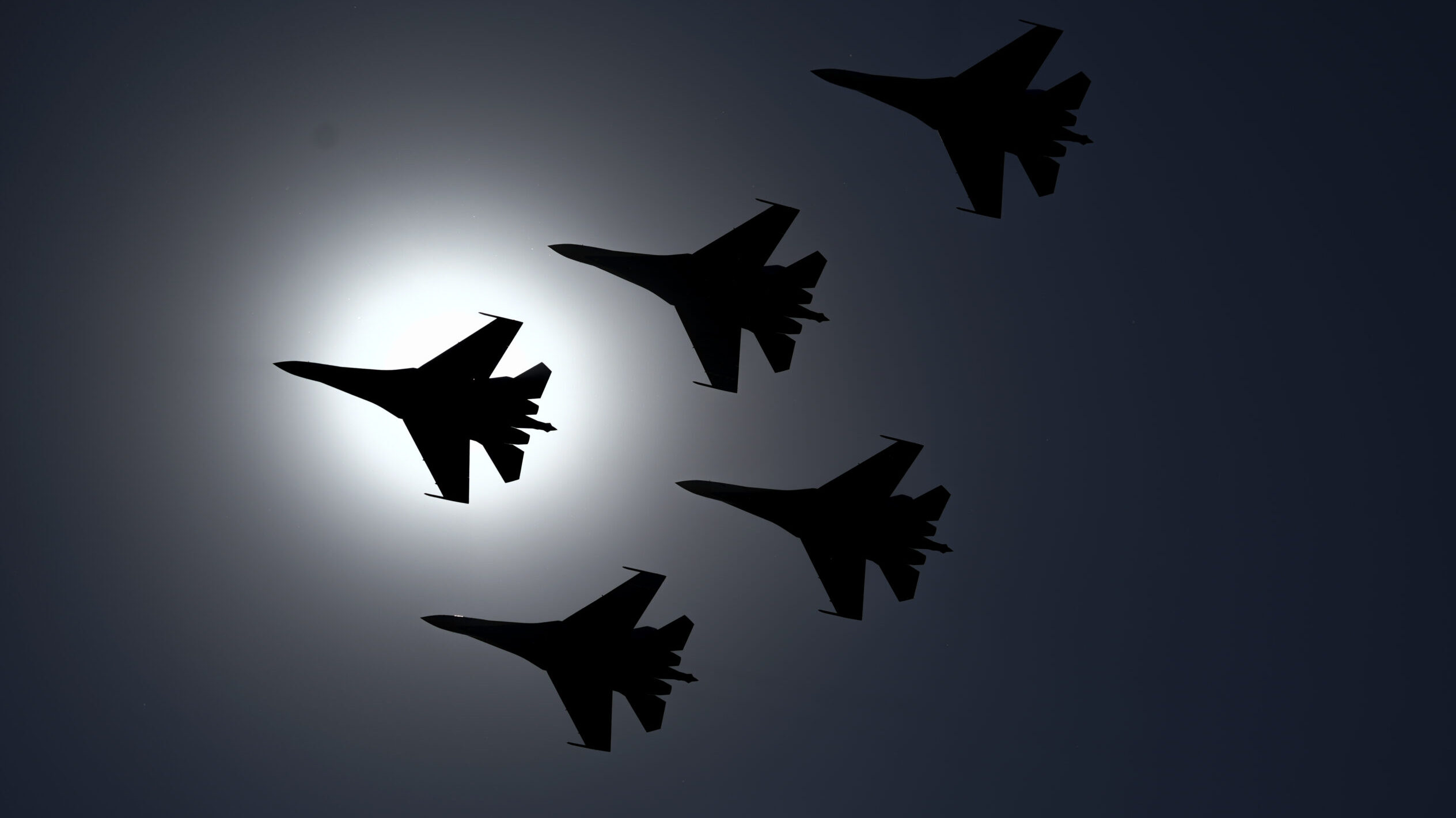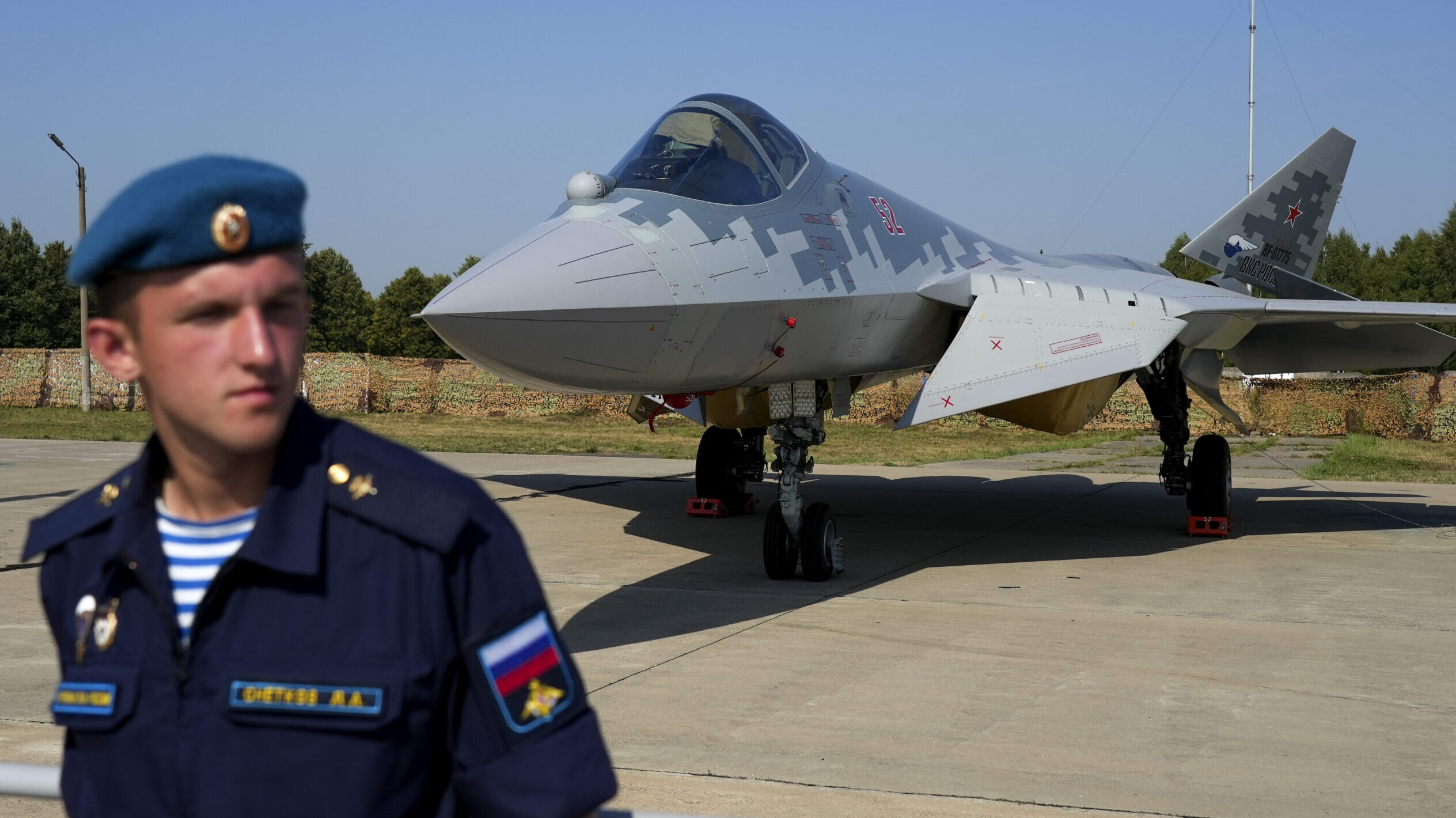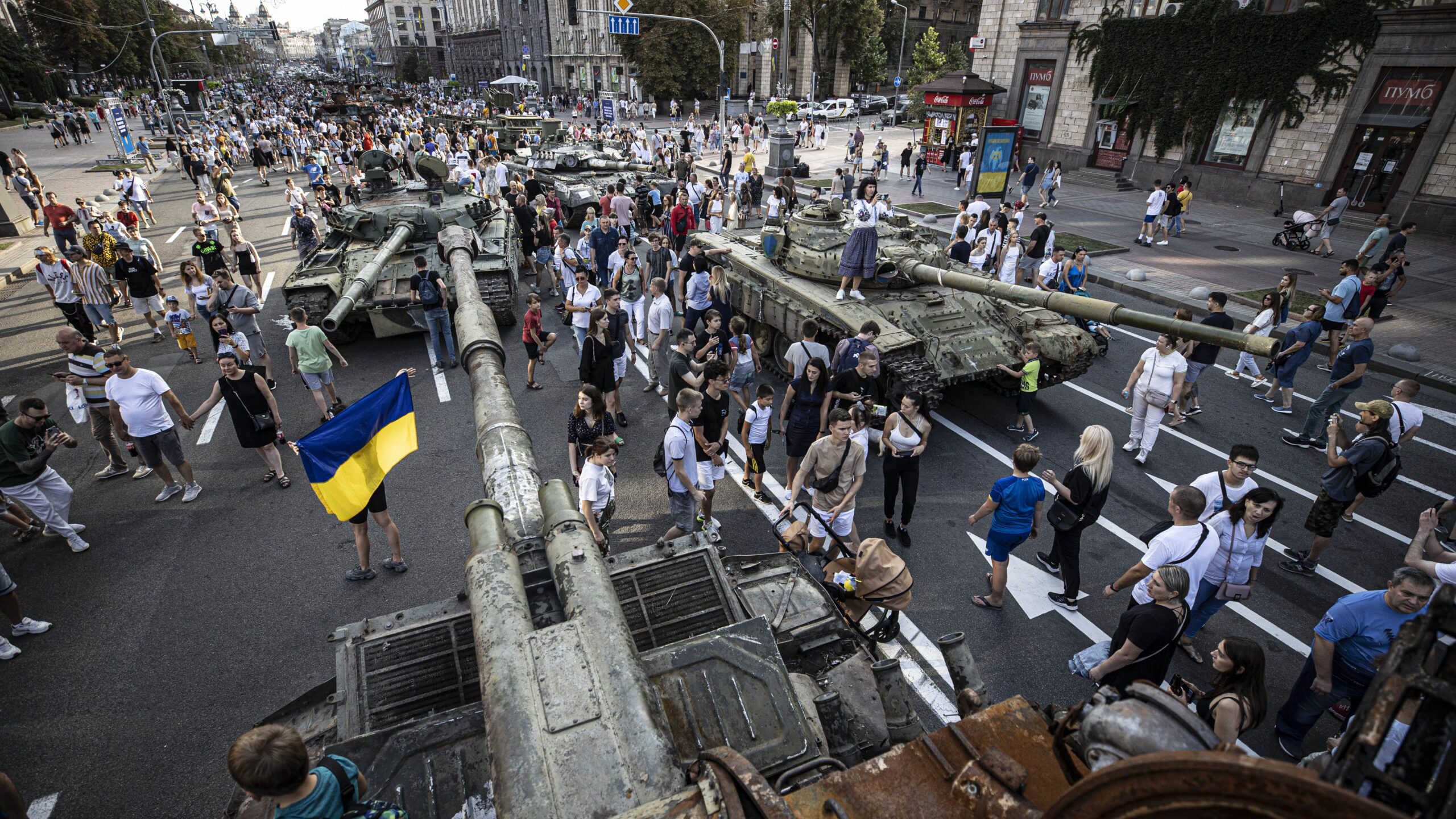
Sukhoi Su-35S aircrafts perform during the International Military-Technical Forum “Army 2022” at Kubinka military training ground in Moscow, Russia on August 17, 2022. (Pavel Pavlov/Anadolu Agency via Getty Images)
FT. LAUDERDALE, Fla. — It was an eye-opening scene, even by the standards set in Moscow over the last year. In a recording of a Jan. 11 call, President Vladimir Putin ripped into Deputy PM and Minister of Trade and Industry, Denis Manturov, over the slow production rates of key defense equipment.
In the recording of the conference call released by the government-run RIA Novosti news service, Putin is described as “humiliating” Manturov after the latter corrected the Russian president over his charge that defense enterprises had not yet secured contracts for the manufacture of replacement fighters.
“So? When will this be sorted?” Putin asked pointedly, eventually commanding that contracts for equipment, especially fighters, be locked in “no later” than within a month — and while the “or else” may have been silent, it was impossible to miss.
This manner of public castigation is almost unique in Manturov’s career. For years he has been what many had described as the “golden child” of the government’s defense industrial officialdom. He has been promoted from one position to another for more than two decades and had largely escaped any blame being placed on him for the increasing downturn in the industry’s overall fortunes. He is also related to Rostec CEO Sergei Chemezov, one of Putin’s closest and oldest associates.
But, after this chastisement in prime time, “you have to ask yourself if Manturov is going to be the next one of Putin’s cronies you read about mysteriously falling out of a window somewhere,” joked one Moscow-based defense analyst, speaking to Breaking Defense on agreement of anonymity.
RELATED: Russia’s New SU-75 Checkmate Promises A Lot. Can It Deliver?
The entire scene speaks to the growing reality within Russia that if it is to continue to prosecute its invasion of Ukraine, it needs to find a way to increase its defense manufacturing. It’s clear Moscow is scrambling: On Jan. 13, the UK MoD issued a statement assessing that Russia’s UVZ has begun using convict labor to help build tanks, noting “Convict labor will likely be particularly in demand from manufacturers of relatively low-tech weaponry such as UVZ, which are almost certainly under pressure from Moscow to increase their production.”
But years of internal rot and corruption, combined with global sanctions, means the task may be all but impossible, no matter how commanding Putin sounds or what forced labor can be thrown at the issue. And it’s a particularly acute concern when it comes to aircraft production.
Russia currently has three major aircraft production sites for Sukhoi aircraft: the Komsomolsk-na-Amure plant (Su-35 and the 5th-generation Su-57), Irkut (S-30SM2) and the NAPO plant in Novosibirsk (Su-34). These facilities are comparable in size to the Boeing/St. Louis factory that was the original McDonnell-Douglas combat aircraft production center.
Yet, according to the best open-source estimates available, Russia’s aerospace forces (VKS) received only 15 total Su-35 and Su-57 models for the year 2022, a maximum of 12 Su-34s from NAPO and only four of the Su-30SM2 models, the latter which were delivered to naval aviation units. This for a total of only 31 aircraft. These numbers do not include any units that might have produced for export contracts, but for more than a year now Russia’s aerospace sector has failed to meet the planned deliveries specified by the GosOboronZakaz, or state defense orders.
In late 2021, Breaking Defense learned from a source in Russia that the plan for the majority of the Komsomolsk production line had to be deferred to 2022. Those numbers were subsequently reduced by the impact of sanctions on the ability of Russian defense plants to source critical components from abroad. This impacts not only what the VKS can expect in deliveries to replace its losses, but also for export customers that provide badly-needed revenue to Russia’s industry.
Even if after export buyers are still interested in Su-35s or some other fighter buy after their poor showing in Ukraine “Russia’s aerospace sector isn’t likely to have aircraft to sell, even if it wants to,” wrote analyst John V. Parachini, in a recent RAND report.
And it has been a poor showing in Ukraine, indeed. Despite the expectation that Russia’s larger, more advanced fleet would quickly establish air dominance, VKS losses have been high: at least 66 different combat aircraft, which includes 11 Sukhoi Su-30SM multirole fighters and 18 of the Su-34 side-by-side regional, medium range strike aircraft. The latter is the most expensive of all the Sukhoi models and is produced at a rate far too low to replace these shot down anytime soon.
Sanctions Impact, Brain Drain Leave Few Options
Experienced observers of Russia’s defense sector point out that the US-led sanctions have a disproportionate effect on aerospace production, more so than any other sector.
Tank plants and production facilities charged with building less technologically complicated platforms can turn to importing refrigerators, washing machines and other household appliances to salvage the microchips inside, explained a Ukrainian defense electronics executive familiar with Russia’s industry who spoke to Breaking Defense.
“But this is not going to help you produce an airborne radar set or an EW module or a raft of the latest model seeker heads,” he said. “Production for some of the most critical subsystems for Russian fighters has almost seized up. Problematic items like the Su-35’s Irbis passive electronically scanning array (PESA) radar antenna can require a year or more — and that is in times of no embargoes, no supply disruptions.”
These problems become several orders of magnitude greater when it comes to maintaining Russia’s fleet of strategic bombers. Just after the new year, the VKS moved the Tupolev Tu-95 and Tu-22M3 bombers and other assets from the Engels-2 airbase where they had been based, largely due to attacks on the aerodrome by the Ukrainians that had damaged some of these aircraft.

A soldier is seen in front of the a Sukhoi Su-57 aircraft during the International Military-Technical Forum “Army 2022” at Kubinka military training ground in Moscow, Russia on August 17, 2022. (Pavel Pavlov/Anadolu Agency via Getty Images)
Their new base at Ukrainka-Seryshevo in the Amur region of Russia is 6,000 kilometres (3,728 miles) from the Ukrainian border and far from the range of any attack drones. But it also means that these aircraft that were the image of Russia’s airpower might during the Cold War will incur far more wear and tear as they launch missions. A former Russian military aircraft design bureau engineer noted there will be far more accumulation of far more flight hours than they would have before.
Fighter aircraft models can still be produced today, he explained, “because during the Russian economic collapse of the 1990s those factories staved off bankruptcy and having to shut down completely by making sales to China, India, Algeria, Malaysia, etc.”
“But no one was — or has since — purchased any Russian bomber aircraft, so those production lines are gone and the people that used to work on them scattered to who-knows-where,” he continued. “Tupolev design bureau as an entity also does not even exist anymore. The building where it used to be housed is now rented out to a commercial company.”
“Once the flight service hours of these bombers are expended and they must be retired — that asset is finished. There is nothing to replace them with.”
RELATED: In North Africa, a fighter jet arms race, with Russia and the US on either side
A similar calculation about hoarding assets that are difficult to replace now also seems to be the case with the newest Russian fighter aircraft, the Su-57. An early January assessment by UK MoD intelligence is that while the aircraft has been employed in the conflict, its role has been “limited to flying over Russian territory, launching long-range air-to-surface or air-to-air missiles into Ukraine” from this safe haven.
“Russia is highly likely prioritising avoiding the reputational damage, reduced export prospects, and the compromise of sensitive technology which would come from any loss of an [Su-57] Felon over Ukraine,” read the UK report, and that this restrictive deployment is “symptomatic of Russia’s continued risk-averse approach to employing its air force in the war.”
Russia will now continue to try and compensate for what it has lost in combat and to maintain force levels. But, with the fortunes of its industrial base constantly falling and the sophistication of the weapons being provided to Ukraine continuing to increase, this could be an impossible set of objectives.
Beyond Jets, Similar Challenges
While concerns about aircraft production have been floating in the background, there has been plenty of out-in-the-open concerns about ground vehicles.
Experienced analysts of Russia’s defense sector are now categorizing Russia’s battlefield losses are “irreversible” and with no chance of pre-war levels of inventories being realized any time in the near future. Losses in Ukraine — estimated to be more than 1,500 tanks — cannot even come close to being replaced one-for-one due with new models to the low rates of production within Russia’s defense industry.
This has prompted desperation tactics on the part of senior Russian government officials, including pulling older-model tanks and other armored vehicles out of long-term, conservation storage and pressing them into use on the battlefield.

Ukrainians arrive at Khreschatyk Street to see the seized military equipment and weapons including tank and motorized artillery systems belonging to the Russian army displayed by Ukraine ahead of the country’s 31st anniversary of Independence Day in Kyiv, Ukraine on August 21, 2022. (Photo by Metin Aktas/Anadolu Agency via Getty Images)
Another tactic appears to be attempts at cost cutting by cutting capability. This past October, a number of latest production models of the T-90 tank were shipped to the front lines in Ukraine — without the numerous features that are normally part of the tank’s standard configuration. A train carrying eight new-production units showed that all of these T-90s lacked the external reactive armor compartments that provide protection against ATGMs. The tanks were also minus the external armaments normally bolted on before being issued to operational units.
RELATED: As Ukraine counterattacks, Russia’s military facing steep artillery, resupply challenges
Behind the lines, there are signs of desperation as well from top officials.
In late October, the Deputy Director of Russia’s Security Council, Former President and PM Dmitri Medvedev visited the UVZ factory, ostensibly for the purpose of motivating the factory management to re-double their efforts. He came dressed to impress.
As the Russian political and military analyst Aleksandr Djokic commented at the time — Medvedev was sporting a black “leather overcoat like the NKVD (the forerunner of the Cold War KGB) agents used to wear during the Stalinist era. He’s officially hit the bottom of absurdity.”
“Every day a new low,” Djokic wrote on his Twitter page. “If this goes on for a couple more months it will become completely surreal.”
“The goal has been set for a scrupulous execution of the government’s defense contracts in all of its key parameters, [and] prevention of disruptions in the supply of equipment,” Medvedev posted on his Telegram channel after the visit. “Attention has been drawn to the fact that all contractors could be held to account, including on criminal charges… Supervision over the execution will continue.” (Just what he actually meant by “execution” was left somewhat ambiguous.)
Medvedev’s “costume for dramatic effect,” as it was described by the Russian defense industry analyst who spoke to Breaking Defense, came as he used the occasion of the plant tour to warn its managers of the consequences of failing to meet their production targets. “It is symbolic of the old Stalin formula of ‘medals or prison’ from the war years,” said the analyst, speaking on the line from Moscow. “If you ‘fulfil the plan’ then you are rewarded, but if you fail to deliver then it is ‘off to the gulag’.”
So in that regard, perhaps Putin’s dressing down of Manturov wasn’t so surprising after all. What happens if production on aircraft doesn’t ramp up may be ugly for Manturov — and Russia’s campaign in Ukraine.
From F-16s to NATO, Argentina’s moves tilt West, but ties to China to last
There are flashpoints to watch as Argentina navigates its future between the polar attractions of Washington and Beijing, including future defense deals and a deep space facility.


























